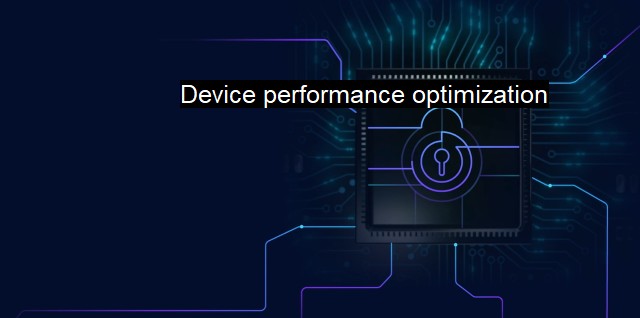What is Device performance optimization?
The Importance of Comprehensive Cybersecurity: Maximizing Device Performance and Protecting Sensitive Info in the Digital Age
Device performance optimization in the context of cybersecurity and antivirus refers to enhancing the operation of computing systems or other electronic instruments for effectiveness while maintaining high levels of security. Given the soaring number of cyber threats and evolving malicious software, security protocols should aim at emotionless flexibility of system operation without hindering performance or stability.Devices such as computers, smartphones, and tablets often have various optimization processes incorporated into their software, including antivirus software. Cybersecurity providers are making it their mandate to offer jet expertise in enhancing device performance while maintaining or increasing the security statistics. In large organizations, one outstanding approach is applying cybersecurity parameters to reinforce data privacy and protect against illegal access while simultaneously working tirelessly to strengthen system performance.
Device performance optimizations demand both hardware and software modifications. These changes aim to design parameters enabling the harmonious operation of hardware and software to yield a smooth machine operation experience. Critics might suggest that enforcing robust antivirus measures often take a toll on device performance as it significantly increases the workload. Still, with sophisticated inventiveness, one can strike a balance between robust cybersecurity and device performance optimization.
In the software aspect, optimization often comes in forms such as upgrading device operating systems, updating applications, and regulating system parameters. For instance, software patches or digital "bandaids" that act as quick temporary solutions for various issues can optimize the overall performance and use while enhancing device security.
One of the significant elements of device performance optimization is implementing a robust antivirus system. A sound antivirus design helps optimize device performance through regular system scans, which checks for malicious software that might be clogging up the system and hindering performance, eliminating them in the process. Antivirus notifications set reminders for crucial updates, thereby helping individuals maintain top software performance while offering the surety of cutting-edge malware defense.
Discussions on device performance optimization in the paradigm of cybersecurity wouldn't be exhaustive without discussing hardware components. These are the tangible components of a device; motherboard, central processing unit (CPU), memory (Random Access Memory and Read-Only Memory), storage devices (hard disk, SSD), etc. More often than not, the overall performance of a computer relies heavily on its hardware configuration. For instance, having a larger RAM and a quicker processor provides more room for a robust antivirus program to operate without significantly affecting system performance.
Another example is Secure Hardware Encryption on storage devices, also optimizing performance while maintaining high security levels. In this, cryptographic measures are applied directly on the hardware, increasing the speed and efficiency of the encryption and decryption processes, considerably enhancing synergized performance and security.
Device performance optimization transcends enhancing the speed and responsiveness of equipment. it guises itself as a mandatory activity — combining the requirements of performance and system hardening against cyber threats and malicious attacks.
Thus, optimal performance in a device is not just about hardware and software speed but also about maintaining the highest level of security necessary for its operation. Integrating antivirus solutions and cybersecurity measures effectively results in an optimized device working seamlessly without security concerns.
Contemporary technology promises an increase in the push for device performance optimization guided by robust cybersecurity systems. As the scale of businesses increase and the confusion introduced by cyber threats amplifies, consistent hand in glove cooperation between performance and cybersecurity will be tomorrow’s norm. Though complex to accomplish, striking a balance among performance optimization and cyber protection unveils an immense advantage — a seamless and secure overall computing experience.

Device performance optimization FAQs
What is device performance optimization?
Device performance optimization refers to the process of improving the speed, efficiency, and overall performance of electronic devices such as computers, smartphones, and tablets. This involves a series of actions that aim to clean up and optimize a device's storage, network, and computing resources, and eliminate any factors that may slow down the system.Why is device performance optimization important for cybersecurity?
Device performance optimization is crucial for cybersecurity because a slow, inefficient device is more vulnerable to cyber threats such as malware, viruses, and hacking attacks. By optimizing the performance of a device, users can reduce the risk of cyber attacks and protect sensitive data and information from being compromised.What are some common methods of device performance optimization?
There are several ways to optimize device performance such as deleting unnecessary files and programs, clearing cache and temporary files, disabling startup programs, updating software and drivers, and increasing RAM or storage space. Users can also use antivirus and security software to scan for malware and other potential threats that may be slowing down the system.How often should I optimize my device's performance?
Device performance optimization should be done regularly to maintain a healthy and efficient system. The frequency of optimization depends on various factors such as the type of device, the user's workload, and the amount of resources available. However, it is recommended to optimize your device's performance at least once a month or whenever you experience noticeable slowdowns or performance issues.| | A | | | B | | | C | | | D | | | E | | | F | | | G | | | H | | | I | | | J | | | K | | | L | | | M | |
| | N | | | O | | | P | | | Q | | | R | | | S | | | T | | | U | | | V | | | W | | | X | | | Y | | | Z | |
| | 1 | | | 2 | | | 3 | | | 4 | | | 7 | | | 8 | | |||||||